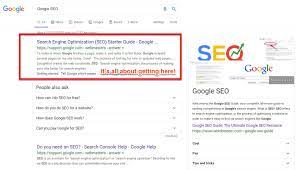Unlocking the Power of Google SEO Optimization
In today’s digital landscape, having a strong online presence is crucial for businesses of all sizes. With millions of websites competing for attention, how can you ensure that your website stands out? The answer lies in Google SEO optimization.
Google, being the most popular search engine worldwide, holds immense power in driving organic traffic to your website. By optimizing your website according to Google’s algorithms and best practices, you can improve your chances of ranking higher in search results and reaching your target audience effectively.
So, what exactly is Google SEO optimization? It refers to the process of making strategic changes to your website’s structure, content, and technical aspects to enhance its visibility and relevance to search engines. Here are some key areas to focus on:
- Keyword Research: Understanding the keywords that users are searching for in relation to your business is essential. Conduct thorough keyword research to identify relevant terms and phrases that align with your products or services. Incorporate these keywords naturally into your website’s content, titles, headings, and meta descriptions.
- Quality Content: Creating high-quality, informative content is paramount for successful SEO optimization. Google values websites that provide value to users. Develop engaging blog posts, articles, videos, or infographics that address common queries or challenges faced by your target audience.
- On-Page Optimization: Optimizing each individual webpage on your site is crucial for better rankings. Pay attention to elements such as title tags, meta descriptions, headers (H1-H6), URL structure, image alt tags, and internal linking. Ensure these elements accurately reflect the content while incorporating relevant keywords where appropriate.
- Mobile-Friendly Design: With mobile devices accounting for a significant portion of web traffic today, having a mobile-friendly website is no longer optional—it’s essential! Google prioritizes mobile-friendly websites in its search results pages (SERPs). Make sure your site is responsive and loads quickly on mobile devices.
- Technical SEO: Optimizing the technical aspects of your website can significantly impact its performance. Factors like site speed, crawlability, XML sitemaps, robots.txt file, and structured data markup play a crucial role in how search engines perceive and rank your site.
- Backlinks: Building high-quality backlinks from reputable websites is an important aspect of Google SEO optimization. It demonstrates to search engines that your website is trustworthy and authoritative. Focus on acquiring natural backlinks through guest blogging, content promotion, or influencer collaborations.
- User Experience: Google prioritizes websites that provide a positive user experience. Ensure your website is easy to navigate, visually appealing, and loads quickly across all devices. User-friendly interfaces and intuitive navigation will keep visitors engaged and encourage them to stay longer on your site.
Remember that SEO optimization is an ongoing process. Google’s algorithms are continually evolving, so it’s crucial to stay updated with the latest trends and best practices in the field of search engine optimization.
By investing time and effort into Google SEO optimization, you can position your website for success in the digital realm. Higher rankings in search results translate into increased visibility, organic traffic, and ultimately more opportunities for growth and success for your business. So embrace the power of Google SEO optimization today!
9 Frequently Asked Questions about Google SEO Optimization in the UK
- What is Google SEO optimization?
- How do I optimize my website for Google?
- What are the best practices for optimizing a website for Google?
- How can I improve my website’s ranking on Google?
- How can I track the performance of my SEO efforts?
- What types of content should I create to improve my SEO rankings?
- What are the most important factors in achieving good rankings on Google?
- How often should I update my website content to maximize its visibility on search engines like Google?
- Are there any tools or techniques that can help me with optimizing my website for better search engine results pages (SERPs)?
What is Google SEO optimization?
Google SEO optimization refers to the process of improving a website’s visibility and ranking in Google’s search engine results pages (SERPs). It involves implementing various strategies and techniques to align with Google’s algorithms and best practices. The goal is to enhance a website’s relevance, authority, and user experience, ultimately attracting more organic traffic.
Google SEO optimization encompasses several key elements:
- Keyword Research: Identifying relevant keywords and phrases that users commonly search for in relation to your business or industry.
- On-Page Optimization: Optimizing individual webpages by incorporating keywords into titles, headings, meta descriptions, URLs, and content. This helps search engines understand the content’s relevance.
- Quality Content: Creating high-quality, informative content that addresses users’ queries or provides value. This can include blog posts, articles, videos, infographics, and more.
- Technical SEO: Ensuring that the technical aspects of your website are optimized for search engines. This includes factors such as site speed, mobile-friendliness, crawlability, XML sitemaps, structured data markup, and more.
- Backlink Building: Acquiring high-quality backlinks from reputable websites to demonstrate your site’s authority and trustworthiness.
- User Experience: Enhancing the overall user experience of your website by focusing on factors like site navigation, design aesthetics, mobile responsiveness, and page loading speed.
By implementing these strategies effectively and staying updated with Google’s algorithm changes, websites can improve their rankings in search results. Higher visibility leads to increased organic traffic from users actively searching for products or services related to their business. Ultimately, Google SEO optimization aims to drive targeted traffic to a website and increase its online presence for improved business outcomes.
How do I optimize my website for Google?
Optimizing your website for Google involves several key steps that can improve its visibility and ranking in search engine results. Here are some essential tips to help you get started:
- Conduct Keyword Research: Identify relevant keywords and phrases that your target audience is likely to use when searching for products or services similar to yours. Use keyword research tools to find popular search terms and incorporate them naturally into your website’s content.
- Create High-Quality Content: Develop informative, engaging, and unique content that addresses the needs and interests of your target audience. Focus on providing value through blog posts, articles, videos, or infographics. Ensure your content is well-written, properly formatted, and optimized with relevant keywords.
- Optimize On-Page Elements: Pay attention to on-page elements such as title tags, meta descriptions, headers (H1-H6), URLs, image alt tags, and internal linking. Craft compelling titles and descriptions that accurately represent your page’s content while incorporating relevant keywords where appropriate.
- Mobile-Friendly Design: With the majority of internet users accessing websites through mobile devices, having a responsive design is crucial. Ensure your website is mobile-friendly and provides a seamless user experience across different screen sizes.
- Improve Page Speed: Google considers page loading speed as an important factor in its ranking algorithm. Optimize your website’s performance by minimizing file sizes, leveraging browser caching, compressing images without compromising quality, and using a content delivery network (CDN) if necessary.
- Enhance User Experience: Make sure your website is easy to navigate with clear menus and logical site structure. Provide intuitive user interfaces and ensure all links are working correctly. Aim for a visually appealing design that encourages visitors to stay longer on your site.
- Build Quality Backlinks: Acquire high-quality backlinks from reputable websites in your industry or niche. Focus on natural link-building strategies such as guest blogging or collaborating with influencers. Avoid spammy or low-quality backlinks, as they can harm your site’s reputation.
- Utilize Social Media: Engage with your audience through social media platforms to increase brand visibility and drive traffic to your website. Share your content, interact with followers, and encourage social sharing of your website’s pages.
- Monitor and Analyze: Regularly monitor your website’s performance using tools like Google Analytics or other SEO analytics platforms. Track metrics such as organic traffic, bounce rate, click-through rate (CTR), and keyword rankings. Analyze the data to identify areas for improvement and make data-driven decisions.
Remember that SEO is an ongoing process, and it takes time to see results. Stay updated with Google’s algorithm changes, industry trends, and best practices in SEO to ensure continued optimization of your website for better visibility on search engine results pages (SERPs).
What are the best practices for optimizing a website for Google?
Optimizing a website for Google involves implementing various best practices to improve its visibility and relevance in search results. Here are some key strategies to consider:
- Keyword Research: Conduct thorough keyword research to identify relevant terms and phrases that your target audience is searching for. Use tools like Google Keyword Planner or SEMrush to find high-traffic keywords with moderate competition. Incorporate these keywords naturally into your website’s content, titles, headings, and meta descriptions.
- High-Quality Content: Create valuable, informative, and engaging content that addresses the needs and interests of your target audience. Focus on providing unique insights, solving problems, or answering common questions related to your industry. Use a mix of text, images, videos, and infographics to make your content more appealing.
- On-Page Optimization: Optimize individual webpages by paying attention to elements such as title tags, meta descriptions, headers (H1-H6), URL structure, image alt tags, and internal linking. Ensure these elements accurately reflect the content while incorporating relevant keywords where appropriate.
- Mobile-Friendly Design: With mobile devices driving a significant portion of web traffic today, having a mobile-friendly website is crucial. Ensure your site is responsive and adapts seamlessly to different screen sizes. Optimize page load times for mobile devices by compressing images and minimizing unnecessary scripts or plugins.
- Technical SEO: Improve technical aspects of your website that impact its performance in search results. Focus on factors such as site speed optimization, crawlability (ensuring search engines can easily access and index your pages), XML sitemaps creation/submission, robots.txt file configuration (to control crawler access), and structured data markup implementation (to provide additional context to search engines).
- Backlink Building: Earn high-quality backlinks from reputable websites in your industry or niche. Natural backlinks demonstrate the authority and trustworthiness of your website. Seek opportunities for guest blogging, content promotion, or influencer collaborations to acquire valuable backlinks.
- User Experience: Google values websites that provide a positive user experience. Ensure your website is easy to navigate, visually appealing, and loads quickly across all devices. Optimize your site’s structure and layout for intuitive navigation. Improve page load times by optimizing code, compressing images, and utilizing caching techniques.
- Regular Updates and Maintenance: Keep your website up-to-date by regularly publishing fresh content, updating outdated information, fixing broken links, and resolving any technical issues that may arise. Regular maintenance ensures your website remains relevant and functional for both users and search engines.
Remember that SEO optimization is an ongoing process. Stay informed about the latest algorithm updates and industry trends to adapt your strategies accordingly. By following these best practices, you can enhance your website’s visibility in Google’s search results and attract organic traffic to fuel your online success.
How can I improve my website’s ranking on Google?
Improving your website’s ranking on Google requires a combination of strategic efforts and ongoing optimization. Here are some key steps you can take to enhance your website’s visibility and increase its chances of ranking higher on Google:
- Relevant Keywords: Conduct thorough keyword research to identify the terms and phrases your target audience is searching for. Incorporate these keywords naturally into your website’s content, titles, headings, meta descriptions, and image alt tags.
- High-Quality Content: Create valuable, informative, and engaging content that addresses the needs and interests of your target audience. Regularly publish fresh content such as blog posts, articles, videos, or infographics that provide value and encourage user engagement.
- On-Page Optimization: Optimize each webpage on your site by paying attention to elements such as title tags, meta descriptions, headers (H1-H6), URL structure, image alt tags, and internal linking. Ensure these elements accurately reflect the content while incorporating relevant keywords where appropriate.
- Mobile-Friendly Design: Make sure your website is responsive and provides a seamless experience across all devices. Google prioritizes mobile-friendly websites in its search results pages (SERPs), so it’s essential to have a design that adapts to different screen sizes.
- Technical SEO: Optimize the technical aspects of your website to improve its performance and search engine visibility. Factors like site speed, crawlability, XML sitemaps, robots.txt file, and structured data markup play a crucial role in how search engines perceive and rank your site.
- Backlinks: Build high-quality backlinks from reputable websites within your industry or niche. Acquiring natural backlinks through guest blogging, content promotion, or influencer collaborations can demonstrate to search engines that your website is trustworthy and authoritative.
- User Experience: Focus on providing a positive user experience on your website. Ensure easy navigation, fast loading times, intuitive design elements, clear calls-to-action, and valuable content that keeps visitors engaged and encourages them to stay longer on your site.
- Social Signals: Engage with your audience on social media platforms and encourage social sharing of your content. Social signals can indirectly influence search engine rankings by increasing brand visibility, driving traffic, and generating backlinks.
- Local SEO: If you have a physical location or serve a specific geographic area, optimize your website for local searches. This includes creating a Google My Business profile, optimizing local citations, and incorporating location-specific keywords in your content.
- Analytics and Monitoring: Regularly monitor your website’s performance using tools like Google Analytics to gain insights into user behavior, traffic sources, and keyword performance. Use this data to make informed decisions and continually optimize your website for better rankings.
Remember that improving your website’s ranking on Google is an ongoing process. Stay updated with the latest trends, algorithm changes, and best practices in SEO to ensure long-term success in search engine rankings.
How can I track the performance of my SEO efforts?
Tracking the performance of your SEO efforts is essential to understand the effectiveness of your strategies and make informed decisions for optimization. Here are some effective ways to track and measure the performance:
- Google Analytics: Set up Google Analytics on your website to gain valuable insights into various metrics. It provides data on organic traffic, user behavior, bounce rates, conversions, and more. Monitor key performance indicators (KPIs) such as organic sessions, average time on page, and goal completions to assess the impact of SEO efforts.
- Keyword Rankings: Monitor your website’s rankings for target keywords using tools like SEMrush or Moz. Track changes in rankings over time to evaluate the progress of your SEO campaigns. Focus not only on ranking positions but also on the visibility and click-through rates (CTRs) associated with those rankings.
- Backlink Analysis: Regularly analyze your backlink profile using tools like Ahrefs or Majestic. Keep an eye on the number and quality of backlinks acquired over time. Look for opportunities to build new high-quality backlinks while disavowing any harmful or low-quality links that may negatively impact your SEO efforts.
- Organic Traffic: Review the organic traffic data in Google Analytics to understand how much traffic is coming from search engines. Monitor trends in organic traffic volume, sources, and landing pages to identify patterns and optimize accordingly.
- Conversion Tracking: Set up conversion tracking within Google Analytics or other analytics platforms to measure how well organic traffic converts into desired actions such as purchases, form submissions, or newsletter sign-ups. This helps you assess the ROI of your SEO efforts.
- Page Speed Performance: Use tools like Google PageSpeed Insights or GTmetrix to measure your website’s loading speed across different devices and browsers. A slow-loading site can negatively impact user experience and search engine rankings.
- User Engagement Metrics: Analyze metrics like bounce rate, time on page, pages per session, and exit rate to gauge user engagement. Higher engagement indicates that visitors find your content valuable and relevant, which can positively impact SEO.
- Social Media Metrics: Monitor social media metrics such as shares, likes, comments, and click-through rates for your content. While not directly related to SEO, social signals can indirectly impact search engine rankings.
Regularly review and analyze these metrics to gain insights into the performance of your SEO efforts. Adjust your strategies accordingly based on the data to continuously improve your website’s visibility, traffic, and conversions.
What types of content should I create to improve my SEO rankings?
Creating diverse and high-quality content is key to improving your SEO rankings. Here are some types of content that can help boost your search engine optimization efforts:
- Blog Posts: Regularly publishing informative and engaging blog posts on topics relevant to your industry can attract organic traffic and establish your website as a valuable resource. Incorporate relevant keywords into your blog content and optimize meta tags for better visibility.
- Infographics: Visual content like infographics can be highly shareable and link-worthy. They provide concise and visually appealing information, making complex concepts easier to understand. Including embed codes with backlinks can help generate backlinks when others share your infographics on their websites.
- Videos: Video content is increasingly popular and can improve user engagement metrics, such as time spent on site. Create videos that offer tutorials, product reviews, or industry insights to enhance the overall user experience. Optimize video titles, descriptions, and tags with relevant keywords.
- Guides and E-Books: Comprehensive guides or e-books that delve into specific topics within your niche can establish you as an authority in the field. Make sure they provide valuable insights and actionable advice to readers.
- Case Studies: Showcasing real-life examples of how your products or services have helped customers achieve success can be compelling content for both potential customers and search engines. Include relevant keywords in the case study titles, headings, and descriptions.
- User-generated Content: Encourage your audience to create content related to your brand or products, such as testimonials, reviews, or social media posts featuring your offerings. User-generated content not only adds credibility but also provides fresh perspectives that search engines value.
- Podcasts: Creating audio-based content through podcasts allows you to reach a different segment of your target audience who prefer consuming information through audio formats. Optimize podcast titles, descriptions, and show notes with relevant keywords.
- FAQs and Q&A Content: Anticipate the questions your target audience may have and create content that answers those queries. Frequently asked questions (FAQs) pages, Q&A blog posts, or video series addressing common concerns can improve your website’s visibility for relevant search queries.
Remember to optimize each type of content with relevant keywords, meta tags, and descriptive titles. Additionally, promote your content through various channels to increase its visibility and encourage others to share or link back to it. Regularly monitoring your website’s performance using analytics tools will help you assess which types of content are resonating with your audience and driving better SEO results.
What are the most important factors in achieving good rankings on Google?
Achieving good rankings on Google requires a combination of various factors. While Google’s algorithms are complex and constantly evolving, here are some of the most important factors that can significantly impact your website’s rankings:
- Relevant and High-Quality Content: Creating valuable, informative, and engaging content is crucial. Focus on providing content that answers users’ queries and addresses their needs. Ensure your content is well-researched, original, and offers a unique perspective. Regularly update your content to stay relevant.
- Keyword Optimization: Conduct thorough keyword research to identify relevant terms and phrases related to your business. Incorporate these keywords naturally into your content, titles, headings, meta tags, and URLs. However, avoid keyword stuffing as it can harm your rankings.
- Backlinks from High-Quality Websites: Building high-quality backlinks from reputable websites is an essential factor in ranking well on Google. Seek opportunities for guest blogging, influencer collaborations, or content promotion to acquire natural backlinks. Focus on quality rather than quantity.
- Mobile-Friendly Design: With the increasing use of mobile devices for web browsing, having a mobile-friendly website is crucial for good rankings. Ensure your website is responsive and provides a seamless user experience across all devices.
- Page Load Speed: Google prioritizes websites that load quickly as it enhances user experience. Optimize your website’s performance by minimizing file sizes, leveraging browser caching, compressing images, and using efficient coding practices.
- User Experience (UX): A positive user experience is vital for good rankings on Google. Create intuitive navigation, clear site structure, easy-to-read content with proper formatting (headings, bullet points), and use multimedia elements effectively to enhance engagement.
- Technical SEO: Pay attention to technical aspects such as crawlability (making sure search engines can access your site), XML sitemaps (helping search engines understand your site’s structure), robots.txt file (controlling search engine access), and structured data markup (providing additional context to search engines).
- Social Signals: While not a direct ranking factor, social signals (such as likes, shares, and comments on social media platforms) can indirectly influence your rankings. Engage with your audience on social media and encourage them to share your content.
- Website Security: Google prioritizes websites that provide a secure browsing experience. Implement SSL certificates (HTTPS) to encrypt data transmission between users and your website. This helps build trust with both users and search engines.
- Regular Updates and Monitoring: Continuously monitor your website’s performance, rankings, and user behavior using tools like Google Analytics and Google Search Console. Regularly update your content, fix broken links, improve user experience, and adapt to changes in search algorithms.
Remember that achieving good rankings on Google is a long-term endeavor that requires consistent effort, optimization, and staying updated with the latest SEO trends and best practices.
How often should I update my website content to maximize its visibility on search engines like Google?
To maximize visibility on search engines like Google, it’s important to regularly update your website content. While there is no specific frequency set in stone, here are some guidelines to consider:
- Freshness: Search engines value fresh and up-to-date content. Regularly adding new content signals to search engines that your website is active and relevant. Aim to update your website with fresh content at least once a month, if not more frequently.
- Quality over Quantity: Instead of focusing solely on updating content for the sake of it, prioritize quality over quantity. Ensure that any updates you make are valuable, informative, and engaging for your audience.
- Evergreen Content: In addition to creating new content, focus on maintaining and updating evergreen content on your website. Evergreen content refers to timeless articles or resources that remain relevant over time. Regularly reviewing and refreshing this type of content helps ensure its accuracy and usefulness.
- Blogging or News Section: If your website includes a blog or news section, aim to publish new articles or posts regularly. This can be weekly, bi-weekly, or even monthly depending on your capacity and industry trends. Consistency is key here – establish a publishing schedule that you can realistically maintain.
- Keyword Optimization: When updating existing content or creating new pages, consider incorporating relevant keywords into your text naturally. This helps search engines understand the relevance of your content and improves the chances of ranking higher in search results.
- User Engagement: Pay attention to user engagement metrics such as bounce rate, time spent on page, and social shares. If certain pages have low engagement rates, consider updating them with fresh information or improving their design and usability.
- Technical Updates: Alongside content updates, regularly check for technical issues such as broken links, page errors (404s), or outdated plugins/themes that may affect user experience and search engine crawling.
Remember that consistency is key when it comes to updating website content. Develop a content strategy that aligns with your resources and goals, and be sure to monitor the impact of your updates through analytics tools. By keeping your website fresh, relevant, and engaging, you can enhance its visibility on search engines like Google.
Are there any tools or techniques that can help me with optimizing my website for better search engine results pages (SERPs)?
Absolutely! There are several tools and techniques available to assist you in optimizing your website for better search engine results pages (SERPs). Here are a few commonly used ones:
- Keyword Research Tools: Tools like Google Keyword Planner, SEMrush, or Moz Keyword Explorer can help you identify relevant keywords and phrases that people are searching for in your industry. These tools provide insights into search volume, competition, and related keywords to help you make informed decisions about optimizing your content.
- SEO Analysis Tools: Tools such as Google Analytics and Google Search Console provide valuable data on your website’s performance, including organic traffic, user behavior, keyword rankings, and technical issues. They help you identify areas for improvement and track the impact of your optimization efforts.
- On-Page Optimization Plugins: Content management systems like WordPress offer plugins such as Yoast SEO or Rank Math that analyze your content for on-page optimization factors. These plugins provide recommendations on keyword usage, readability, meta tags, and other crucial elements to improve your content’s visibility.
- Backlink Analysis Tools: Backlinks from authoritative websites play a vital role in SEO. Tools like Ahrefs or Moz Link Explorer allow you to analyze your backlink profile, identify potential opportunities for acquiring quality backlinks, and monitor the health of your link-building efforts.
- Website Speed Optimization Tools: Page load speed is an important ranking factor. Tools like Google PageSpeed Insights or GTmetrix can analyze your website’s speed performance and provide suggestions on how to optimize it further by compressing images, minifying code, or leveraging caching techniques.
- Mobile-Friendly Testing Tools: With mobile devices accounting for a significant portion of web traffic, it’s crucial to ensure your website is mobile-friendly. Google’s Mobile-Friendly Test tool helps you evaluate if your site meets mobile usability standards and provides recommendations for improvement.
- Structured Data Markup Generators: Adding structured data markup to your website can enhance search engine understanding and visibility. Tools like Google’s Structured Data Markup Helper or Schema.org provide guidance on implementing structured data for various types of content, such as articles, events, products, and more.
Remember, while these tools are helpful, they should be used in conjunction with a solid understanding of SEO best practices. It’s important to continuously educate yourself about the latest trends and techniques in search engine optimization to ensure long-term success.




